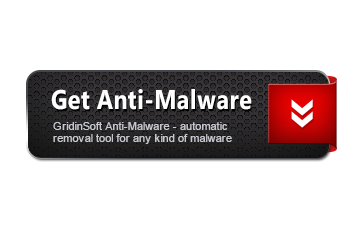The Trojan:Win32/NabucurObfs is considered dangerous by lots of security experts. When this infection is active, you may notice unwanted processes in Task Manager list. In this case, it is adviced to scan your computer with GridinSoft Anti-Malware.

Gridinsoft Anti-Malware
Removing PC viruses manually may take hours and may damage your PC in the process. We recommend using GridinSoft Anti-Malware for virus removal. Allows to complete scan and cure your PC during the trial period.
What Trojan:Win32/NabucurObfs virus can do?
- Behavioural detection: Executable code extraction – unpacking
- SetUnhandledExceptionFilter detected (possible anti-debug)
- Attempts to connect to a dead IP:Port (3 unique times)
- Creates RWX memory
- Dynamic (imported) function loading detected
- Enumerates running processes
- Expresses interest in specific running processes
- Repeatedly searches for a not-found process, may want to run with startbrowser=1 option
- Reads data out of its own binary image
- Manipulates data from or to the Recycle Bin
- A process created a hidden window
- Executed a command line with /V argument which modifies variable behaviour and whitespace allowing for increased obfuscation options
- Drops a binary and executes it
- The binary likely contains encrypted or compressed data.
- Authenticode signature is invalid
- A scripting utility was executed
- Uses Windows utilities for basic functionality
- Uses Windows utilities for basic functionality
- A process attempted to delay the analysis task by a long amount of time.
- Created a process from a suspicious location
- Installs itself for autorun at Windows startup
- Installs itself for autorun at Windows startup
- Attempts to disable UAC
- Anomalous binary characteristics
- Attempts to modify Explorer settings to prevent file extensions from being displayed
- Attempts to modify Explorer settings to prevent hidden files from being displayed
- Uses suspicious command line tools or Windows utilities
How to determine Trojan:Win32/NabucurObfs?
File Info:
name: DAC3585910AC460934A2.mlwpath: /opt/CAPEv2/storage/binaries/ce7111dc3ffc16502cb7b78b727ab56fd1747a77ab2c04c16c4cf1122d481cf1crc32: 0612F172md5: dac3585910ac460934a234b66d60c470sha1: 3f96e2b72197fcefbeaa36d3b11ce7ea51e4041asha256: ce7111dc3ffc16502cb7b78b727ab56fd1747a77ab2c04c16c4cf1122d481cf1sha512: d035309bbaac2dba2788f6c97006330c4d7523371fdcc071fc3f2b3019982bc391602559da7b4656f551e1ea41e1a60e232d7b18ea520e082f0cadf4326cb69essdeep: 12288:N1qq4rD0zvYcXDRSjU9uUSaEBGkbuHaLf4htV4ZeKNCjuAXm0pRceqnkIr7yw:N4xSv5RSP5f4TINs/m00eq/7ywtype: PE32 executable (GUI) Intel 80386, for MS Windowstlsh: T17C85815B66DF9BF67CBB1C230D1BAE9836706740D11F943B289E61C12F00A96363D876sha3_384: d1e6d99a63579b8e129d110bc4395dfbe0c941b889195fef9c48fd31370fa02e0b67c43f872d5102eca9bc28546fbd04ep_bytes: b9e4065ca32bc74b2bf00bf70fcf23c3timestamp: 2018-12-24 06:33:22Version Info:
0: [No Data]
Trojan:Win32/NabucurObfs also known as:
| Bkav | W32.AIDetect.malware1 |
| Lionic | Virus.Win32.PolyRansom.n!c |
| Elastic | malicious (high confidence) |
| MicroWorld-eScan | Win32.Virlock.Gen.5 |
| FireEye | Generic.mg.dac3585910ac4609 |
| CAT-QuickHeal | Ransom.PolyRansom.B2 |
| ALYac | Win32.Virlock.Gen.5 |
| Cylance | Unsafe |
| Sangfor | Suspicious.Win32.Save.a |
| K7AntiVirus | Virus ( 0040f99f1 ) |
| K7GW | Virus ( 0040f99f1 ) |
| Cybereason | malicious.910ac4 |
| Arcabit | Win32.Virlock.Gen.5 |
| Baidu | Win32.Virus.Virlock.a |
| VirIT | Win32.CryptorGen.A |
| Cyren | W32/A-eb557c81!Eldorado |
| tehtris | Generic.Malware |
| ESET-NOD32 | a variant of Win32/Virlock.C |
| APEX | Malicious |
| Paloalto | generic.ml |
| ClamAV | BC.Win.Virus.Ransom-9157.B |
| Kaspersky | Virus.Win32.PolyRansom.a |
| BitDefender | Win32.Virlock.Gen.5 |
| NANO-Antivirus | Trojan.Win32.PolyRansom.exypia |
| SUPERAntiSpyware | Trojan.Agent/Gen-Crypt |
| Avast | Win32:VirLock [Inf] |
| Rising | Virus.VirLock!1.A08A (CLASSIC) |
| Ad-Aware | Win32.Virlock.Gen.5 |
| TACHYON | Virus/W32.VirRansom.C |
| Emsisoft | Win32.Virlock.Gen.5 (B) |
| Comodo | Packed.Win32.Graybird.B@5hgpd5 |
| DrWeb | Win32.VirLock.4 |
| Zillya | Virus.PolyRansom.Win32.2 |
| TrendMicro | PE_VIRLOCK.E |
| McAfee-GW-Edition | BehavesLike.Win32.VirRansom.tc |
| Sophos | ML/PE-A + W32/VirRnsm-A |
| SentinelOne | Static AI – Malicious PE |
| Jiangmin | Win32/Polyransom.a |
| Avira | TR/Crypt.XPACK.Gen7 |
| Microsoft | Trojan:Win32/NabucurObfs |
| GData | Win32.Virlock.Gen.5 |
| Cynet | Malicious (score: 100) |
| AhnLab-V3 | Win32/Nabucur.B |
| McAfee | W32/VirRansom |
| MAX | malware (ai score=83) |
| VBA32 | Virus.VirLock |
| Malwarebytes | Bladabindi.Backdoor.Njrat.DDS |
| TrendMicro-HouseCall | PE_VIRLOCK.E |
| Tencent | Virus.Win32.Polyransom.a |
| Ikarus | Virus.Win32.Nabucur |
| MaxSecure | Virus.PolyRansom.a |
| Fortinet | W32/Virlock.K |
| BitDefenderTheta | AI:FileInfector.47FA551513 |
| AVG | Win32:VirLock [Inf] |
| Panda | Generic Suspicious |
| CrowdStrike | win/malicious_confidence_100% (W) |
How to remove Trojan:Win32/NabucurObfs?
- Download and install GridinSoft Anti-Malware.
- Open GridinSoft Anti-Malware and perform a “Standard scan“.
- “Move to quarantine” all items.
- Open “Tools” tab – Press “Reset Browser Settings“.
- Select proper browser and options – Click “Reset”.
- Restart your computer.



Leave a Comment